The post Hand-To-Hand Lessons from the U.S. Navy appeared first on .
]]>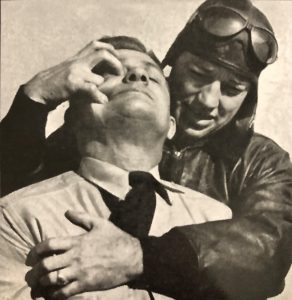
Many today want to reinvent the wheel. This is especially true in martial art and self-defense circles. People want to create their own styles, systems, and martial arts. And while there have definitely been advancements and improvements when it comes to training, nutrition, and equipment, there is still much to be gained by studying the tried and true principles, concepts, and techniques that have been around not only for decades, but sometimes centuries.
In 1943, the United States Naval Institute put out a series of training manuals, including one on hand-to-hand combat prepared by the officers in charge of the instruction of Hand-To-Hand Combat in Naval Aviation. This manual might be dismissed as old and archaic by some, but in fact there are many truths found in this classic text that are still relevant today. The manual starts out by saying there is nothing glamorous or adventurous about hand-to-hand combat, but rather it is simply a cold, efficient method of overcoming your enemy in a manner most suitable to the performance of your mission or the saving of your life. Seems pretty accurate and practical doesn’t it? It was deemed necessary for Naval personnel to be trained in hand-to-hand combat, and there was one simple objective: to WIN!
Today’s self-defense encounters have the same objective. When it is between living or drying, or even being seriously wounded, you must win. In a real self-defense situation, there are no rules, there is nothing sporting about it, there are not referees and no fouls are considered. It’s exactly like the U.S. Navy taught decades ago, “You do to the enemy exactly what he would like to do to you – only, you do it first!”
I teach people how to defend themselves for the same reason the U.S. Navy taught hand-to-hand combat. It provides an additional and vital means of self preservation and increases your chances of surviving a life-and-death struggle. It also increases your chances of escaping a would-be-assailant. A lot can be learned from studying the older manuals and guides to unarmed combat. And as I’ve illustrated, much can be applied to modern self-defense situations. While there are many lessons and techniques found in this text, I’d like to share two important lessons from the U.S. Navy Hand-To-Hand Combat manual.
- “When the critical moment arrives and it is either you or the other fellow in a life and death struggle, it is up to you to use the quickest and deadliest method of liquidating your enemy. Whether you be unarmed, armed with a club, knife, wire, gun, rock, bottle or other weapon, use your feet, hands or weapons to the greatest advantage.”
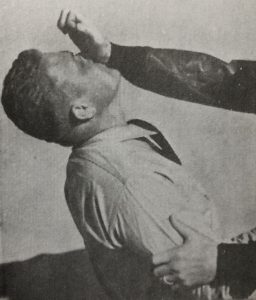
Obviously, this manual was written for those going to war, where killing the enemy before he had a chance to kill you was paramount. But this principle is still important for civilians. You must do whatever it takes, with whatever you have, to keep yourself alive. Certainly, if you can stop an attacker without using lethal force, that is preferred. But in a life-or-death situation where lethal force is the only way to stop an attacker and prevent serious bodily harm or death to yourself or someone else, you must be prepared to do whatever it takes to survive, including using lethal force yourself. You must use whatever you have to your greatest advantage. You must win!
- “A word of caution, however – don’t become too complicated with club maneuvers. Simplicity of action in most cases is far more rapid than complex maneuvers.”
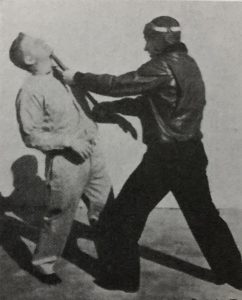
This passage was found in the section on using a club, but is universally true with any form of combat, empty handed or with a weapon. Simplicity of action in most cases is far more rapid than complex maneuvers. Simple gross movements are most often the best for defending yourself. This is true regardless of the weapon or empty handed technique used. This is why the core of most effective means of defending yourself consist of simple techniques and actions. We don’t need to complicate things. In fact, we shouldn’t complicate things. We should strive for simplicity and effectiveness. These really are keys to defending yourself. Keep things simple and keep things effective.
I’m not against the progression of styles and systems, nor do I deny the advancements I mentioned at the beginning of this article. However, I do believe we mustn’t forget the lessons of the past, because many of them are just as applicable today as they were when taught years ago.
U.S. Navy Training Film
Here is a video I found that is an old U.S. Navy Training film from the same time frame of the manual I quoted above.
The post Hand-To-Hand Lessons from the U.S. Navy appeared first on .
]]>The post Self-Defense Against Weapons appeared first on .
]]>When it comes to weapons defense, the weapon is the primary concern, as it is what has the most capability of injuring or killing you, and most likely your opponent’s focus will be on using the weapon against you. According to Echanis, neutralization, stabilization, and disarmament of the weapon are the essential factors in survival.
When it comes to the 4 basic rules in unarmed self-defense against a weapons attack, Echanis taught that the movements and actions must be executed in the exact chronological order he laid them out. His 4 basic rules are, “first you must block and redirect the attack of the weapon to neutralize its lethal capability and clear the body of its trajectory of fire and angle of attack. Second, you must stabilize the weapon by controlling the wrist, hand, and weapon of the attacking arm of the enemy. Third, you proceed to disarm the weapon by breaking the joint of the locked extremity or simply by applying power to induce enough pain for control and disarmament.” And lastly, you must neutralize the enemy.
Or you can look at them this way:
- Clear your body of the weapon’s line of fire and angle of attack.
- Stabilize and control the weapon by breaking the base of the enemy’s balance. You may use low kicking and sweeping, joint locking and breaking and spinning to jerk the enemy off-balance.
- Disarm the weapon by using joint-breaking, throwing and tearing techniques. Focusing his counterattack and mental concentration on the weapon the unarmed soldier never loses control or “feel” for the weapon. His primary concern is this one factor: giving lethality to his assailant’s attack.
- Neutralize the enemy. Once the assailant has been disarmed, the enemy must be neutralized and physical control must be maintained.
Echanis also makes a point to warn people that, “No matter how proficient the unarmed expert becomes at disarming an armed assailant, he will remain vulnerable to even the smallest weapons expert.”
There are other theories and models when it comes to self-defense against weapons. And one could argue about them until the cows come home, and sadly some do. I believe it is more important to study the different models and take what you can to make yourself better than to argue over who or what is right, wrong, or better.
Echanis presents some fundamental concepts regarding self-defense against weapons. Incorporate them into your training, and use them to make your unarmed skills better. It’s the absorb what is useful concept. So please absorb and stay safe!
The post Self-Defense Against Weapons appeared first on .
]]>The post The Chin Jab appeared first on .
]]>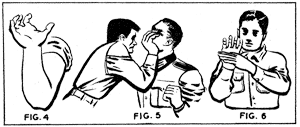
The chin jab is one type of palm heel strike that goes back to the simple and effective techniques taught by Applegate and Fairbairn. It doesn’t take a lot of skill or accuracy to perform, and it is simple to learn, making it an ideal technique to teach for combat or self-defense. It’s a staple of modern Combatives as taught by instructors such as Kelly McCann. The palm heel strike is one of the basic strikes I teach in my Active Shooter/Threat Response and Self-defense courses, and the “Chin Jab” is one of the effective variations of that strike. Add it to your tool box.
Because I was fortunate enough to get to meet and talk a while with Col. Rex Applegate in the 90s, I want to share his description of the chin jab from his classic book Kill Or Get Killed:
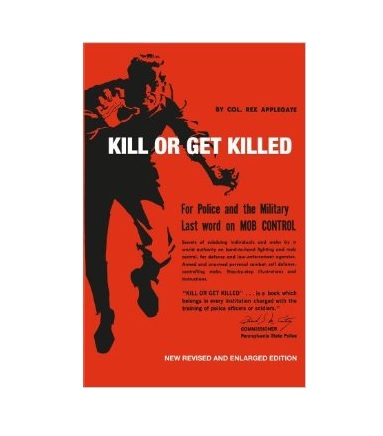
The Chin Jab. Knockout blows delivered to the chin b the fist may not only be ineffective, they also present the danger of a dislocated finger or knuckle, or a cut from the opponent’s bony facial structure. The use of the fist has another shortcoming; that it does not concentrate the force of the blow sufficiently. Any part of the anatomy will collapse if it is struck many times in one place; but the average individual cannot use the fist effectively enough to do great damage in a single blow. The novice should limit the use of his fists to such soft, vulnerable areas as the stomach, groin and kidneys, and rely on other types of blows for other parts of the body.
The extremely effective chin jab is so called because it is used principally in the chin area. It must be delivered up and under the chin with the heel of the palm, fingers extended and spread for palm rigidity. The more directly underneath the chin the blow falls, the more power it will pack. It is executed with a stiff, locked wrist and a bent elbow; and a great deal of upward body force can be utilized at the time of impact. The further forward the chin is extended at the time of the blow, the more devastating the result. If a knee thrust to the testicles or groin is used in connection with the chin jab, the body will be automatically bend forward, leaving a perfect setup for this particular blow. It results in unconsciousness and possible neck fracture, if delivered with sufficient force.
The arm, or hand, does not have to be drawn back in beginning execution of the blow. It can be hanging at the side, fingers hooked in belt, hand resting on a lapel, or in any other nonchalant position. An average man can cause a knockout with only six inches of traveling distance from the start of the blow to the point of impact. The element of surprise is most useful in close quarters, where time, space, or circumstances do not allow the hand and arm to be withdrawn for a long haymaker. A neck fracture can be caused by gripping an opponent’s belt with the left hand and jerking him forward, at the moment of impact with the right. It is also desirable to use the fingers of the striking hand on the eyes following the blow. The heel of the hand also can be used to strike a stunning blow at the base of the skull.
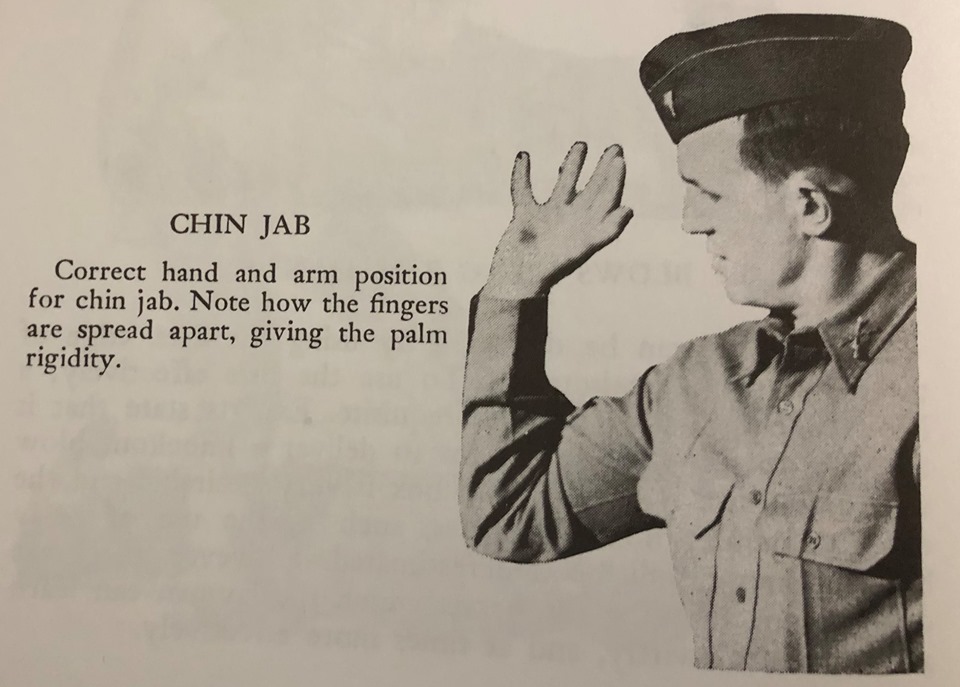
As Col. Applegate described, your arm is bent, making this an in-fighting palm heel, thrown when up close to your opponent. The strike comes up from below your opponent’s field of vision, making it harder to defend against when the opening is available, and allowing you to drive upward and forward with your body to get your weight into the blow. Your goal is to knock the attacker’s head off. When I’m teaching in different states, I tell people to knock his head up to Montana, and I’ll ship it back to them when I get home if they want it and pay for shipping. The blow has a good chance of knocking the attacker unconscious, which is caused when the brain bounces around inside the skull, causing a concussion. There is also the possibility of causing injury to the neck and spinal cord. Because of this, it should only be used to defend yourself when you believe you will be seriously hurt or killed if you don’t. You should always attempt to avoid going physical if you can. A fight not entered is a fight won. You are not hurt and safe, that is the most important thing.
The chin jab can be an effective pre-emptive strike when you know there’s no way out of a situation without using physical force. If an aggressor is in your face and you believe he is about to physically hurt you, driving a chin jab up under his chin may be the perfect technique to allow you to then escape to safety. To use it pre-emptively, it is best launched with surprise from close quarters from a neutral ready stance like the “Jack Benny.”
The chin jab is an effective variation of the palm heel strike, and one you should have in your tool box. Practice launching this blow with explosive power from different positions. You will be glad to have it when it is the tool you need to stay safe.
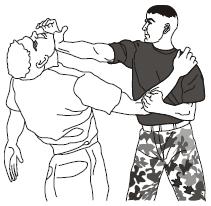
The post The Chin Jab appeared first on .
]]>The post Learn To Strike Fast And Hard appeared first on .
]]>– Phil Giles
I agree with the quote above that Giles wrote in Street Tough: Hard-Core, Anything Goes Street Fighting Fundamentals. Learning to hit, and hit fast and hard, is an essential fighting and physical self-defense tool. With practice and training, you can learn to make your blows fast, powerful, and explosive.
For many, punching has been effective in real fights, and for many, learning to punch correctly and training in effective striking, including closed fist punching, can and should be done. However, I also know that it is easier to break your hand with a closed fist, and for many people, an open hand blow is more effective and can be thrown with less risk to the thrower’s hand. Therefore, I think everyone should train with the open hand palm heel strike, and some should also train with closed fist strikes if they want to add these blows to their striking arsenal.
With both, it’s important to use your body and weight with the strike and not rely on your arm power alone. This can be achieved by stepping with your strike, twisting and driving with the waist and legs, or sometimes by shifting your weight. Most formal training curriculum will teach these various ways to put your weight and motion into your strikes.
I strongly recommend you learn various strikes from a qualified instructor, but if that fails, at least find a good book or video that can help you learn. Then you must practice! Train for both speed and power. Various drills can be performed to make your strikes faster, and good old heavy bag training can help you increase the power of your blows.
Striking techniques are some of the basics that you must master if you want to be a competent fighter and have a better chance at physically defending yourself. But learning them isn’t enough. You must train so you can strike fast and hard.
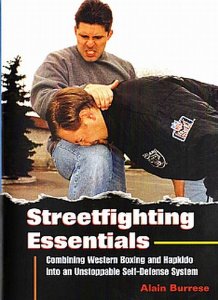 If you are looking for a great primer on self-defense that teaches the basics of striking, check out the DVD set Streetfighting Essentials in Alain’s DVDs.
If you are looking for a great primer on self-defense that teaches the basics of striking, check out the DVD set Streetfighting Essentials in Alain’s DVDs.
The post Learn To Strike Fast And Hard appeared first on .
]]>The post Self-Defense Against A Knife Attack: Things You Should Know appeared first on .
]]>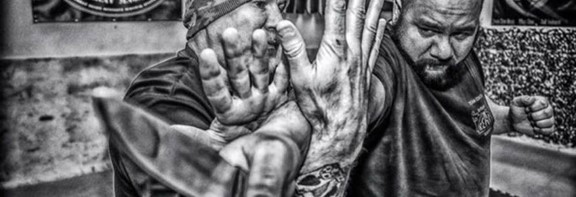
There are basically two types of knife assaults you may encounter. The first is an impending threat, where the attacker brandishes his weapon to intimidate or threaten you to get you to comply with what he wants. This may be to give money, information, or maybe even your physical body. In this assault, the assailant will hold the blade in a threatening manner that you can see, which could be from a distance, or it could be held against your body. Regardless, he is wanting cooperation and for you to do what he wants or give him what he desires. He wants this done without resistance. Usually the blade will be static in this type of assault.
The second assault is a knife attack, where the blade is in motion. The attacker is is coming toward you with a blade and the intent of stabbing or cutting you. He’s not talking, demanding, or negotiating. The knife may be in his forward hand or his rear hand, and as I stated earlier, you may not even know he has a knife until after you have been cut or stabbed.
With an impending threat, you may be able to just run away, or you may be able to satisfy the demand and end the encounter. If he’s demanding money or material possessions, and you can’t run away and escape, you are better off turning them over if it will end the encounter with you unscathed, than attempt to fight a man with a knife unarmed. Don’t risk getting cut or stabbed if you don’t have to.
In the face of a knife attack, you have three options. These are the same three options that you find in my Active Shooter Triangle: Escape, Deny, or Attack Back. If you can escape, that is the wisest option; as I said above, don’t risk getting cut or stabbed if you don’t have to. If you can escape, do so. Unfortunately, escaping is not always a viable option, and then we must deny or attack back.
Deny the attacker access and opportunity to cut or stab you. This can be done in a number of ways. Remember, distance is your friend when facing a knife. The attacker can only cut or stab you when he is close. If you can lock him outside, you have denied him the opportunity to hurt you. The could be locking him outside of the room or office you are in, locking him out of your vehicle, keeping him on the other side of a fence, and so on. Other ways you an deny the attacker are to put something between you such as a table. Grabbing a chair or stool and holding it feet/legs toward your adversary can also be effective. In one of my only knife encounters, this was the strategy I employed and it worked. I ended up throwing the stool at him as I then escaped the bar to avoid both the guy with the knife and the Military Police that were arriving.
And finally, if you can’t escape or deny, you must attack back. Stop the attacker from hurting you by hurting him first. If you can, arm yourself. Something that gains you a distance advantage such as a cane, pool cue, fire extinguisher, etc. is preferred. Use anything that enables you to attack back more effectively. Remember, a knife disarm does not necessarily mean you have to grab and take the knife from the attacker’s hand. If you spray the guy in the face with a fire extinguisher and then smash him in the head with it, causing him to drop the knife, that is a disarm too.
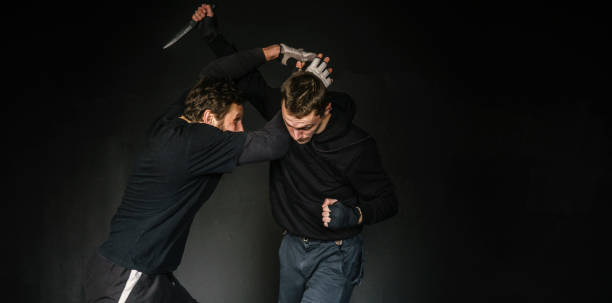
There are empty handed techniques that will work against a knife wielding attacker. Some better than others. They won’t be as easy as in the training hall. Self-defense against a knife attack is never going to be easy. But the techniques can work. And no, don’t “expect to get cut.” I’ve been arguing this point with “experts” since the early 90s. I don’t believe in expecting to get cut. Why buy into a self-fulfilling prophesy. If you are expecting it to happen, there’s a greater chance that it will. You might get cut, and if you do, you have to deal with it. But don’t expect it. Since I started saying this years ago, I’ve heard other instructors that I greatly respect say the same thing. These include Kelly McCann, Bob Kasper, and Nick Hughes. That’s pretty good company to be with, so don’t expect to get cut. (And there are a lot of people who have ended knife altercations without being cut. I didn’t get cut that night I threw the stool at the guy.)
Obviously there is more to know about self-defense against a knife attack. People have written entire books, and made entire video programs, on the topic. I’ll probably write more and make some videos too. But these are a few things you should know when dealing with a knife wielding attacker. Stay sharp and alert and hopefully you’ll never have to deal with the wrong end of a blade.
The post Self-Defense Against A Knife Attack: Things You Should Know appeared first on .
]]>The post Self-Protection versus Self-Defense appeared first on .
]]>Now I’ve read people saying that “self-defense” is a legal term and nothing to do with the physical fighting techniques a person learns to actually debilitate an attacker to enable the person to escape to safety. And I’m guessing some of this notion comes from the writings and teachings of a friend of mine, Marc MacYoung. (It’s been 24 years since the first time we stood on stage together teaching principles to keep people safe.) While I understand that position, and it is true that “self-defense” is a legal term usually denoting the justifiable use of force as an affirmative defense, criticizing people for using it the way it is most commonly used as a means of fighting back against an attacker is not what I want to do here.
Self-Protection
I want to look at the term, and then look at the term Self-Protection. When looking at both terms, I think I am more of a self-protection instructor than a self-defense instructor. That doesn’t mean I am changing what I’ve been teaching for years, just maybe I need to call it something different. Because I’ve always answered that question of “What is self-defense” in my live classes with an answer that includes much more than blocking, striking, kicking, etc. I teach much more than that. I think too many “self-defense instructors” only teach the physical skills of fighting. Their definition of self-defense is those physical skills. And I guess that is okay, but it is not what I do. I teach self-protection, which includes the physical self-defense skills others teach, but also includes much more.
Some of these self-protection principles, strategies, and skills are considered “soft skills” as opposed to the “hard skills” of striking, kicking, etc. These skills are not as “sexy,” but in reality are so much more important. It’s much cooler to think of yourself as Bruce Lee, Chuck Norris, or Keanu Reeves in John Wick after learning some physical fighting or firearms techniques. Some people even post on social media about how they “wish” a bad guy would try something with them so they can show off their skills. In reality, the soft skills of awareness and observation that lead to avoidance of violence are much more useful and practical, and more sure of keeping yourself safe. And that is what self-protection is all about.
And it goes way beyond being physically jumped, beaten, and possibly killed. The principles of self-protection I teach will keep you safe from such dangers, but go way beyond that. I want you to put your seat-belt on and don’t drive distracted or impaired. Way more people will be killed because of ignoring those than will be killed by bad guys jumping out from behind the bushes. While I want you to know where the exits are in your restaurant in case an active shooter comes in and you have to escape (Your first defense if possible), I also want you to know what you are eating and how it affects your heath because way more people will die this year from diseases caused by poor diet and lack of exercise than will be killed by firearms.
The principles, strategies, and tactics I teach regarding self-protection are designed to keep you safe and be prepared if an emergency situation happens. I want you to be healthy and enjoy life safely. Don’t live in paranoia, but be confident and prepared. Practice the safe habits I teach and there is a high probability that you will not need the physical techniques and emergency responses I also teach. But you will be confident because you have a plan and have those skills just in case. So shift your mindset to Self-Protection and enjoy life safely!
The post Self-Protection versus Self-Defense appeared first on .
]]>The post Self Defense Rules with Peyton Quinn appeared first on .
]]> Self-defense instructor and author Peyton Quinn has led the field in reality based self-defense training for many years. His books A Bouncer’s Guide To Barroom Brawling: Dealing with the Sucker Puncher, Streetfighting, and Ambusher and Real Fighting: Adrenaline Stress Conditioning Through Scenario-Based Training do an excellent job of conveying the realities of street fights, violence and the effects of adrenaline stress in these situations. His courses at RMCAT (Rocky Mountain Combat Applications Training) have helped thousands better understand the effects of adrenaline and how to use the stress to defend oneself.
Self-defense instructor and author Peyton Quinn has led the field in reality based self-defense training for many years. His books A Bouncer’s Guide To Barroom Brawling: Dealing with the Sucker Puncher, Streetfighting, and Ambusher and Real Fighting: Adrenaline Stress Conditioning Through Scenario-Based Training do an excellent job of conveying the realities of street fights, violence and the effects of adrenaline stress in these situations. His courses at RMCAT (Rocky Mountain Combat Applications Training) have helped thousands better understand the effects of adrenaline and how to use the stress to defend oneself.
At the 2013 annual Animal List BBQ, I had the opportunity to assist Peyton with a class he was teaching. We’ve taught these concepts before, and it was great to work together again. Here is a clip from that live training. (Some language not appropriate for work or young viewers.)
The difference between passive, aggressive and assertive responses to violent approaches is such an important thing to learn. I especially like how Peyton emphasizes that only the assertive response is chosen by you and controlled by you. It is important to not only understand this, but to actually practice assertive responses so you can choose to respond this way and successfully de-escalate and avoid violence, and in the worst situations at least be ready to respond physically if you have no other choice.
Peyton Quinn’s Rules for Dealing with Stand-up Aggression
1. Don’t insult them
2. Don’t challenge them or accept their challenge
3. Give them an easy face-saving exit.
Peyton shares these self-defense rules in this video:
In A Bouncer’s Guide to Barroom Brawling: Dealing with the Sucker Puncher, Streetfighter, and Ambusher, Peyton Quinn also shares these Fundamental Elements of Avoidance Tactics:
- Show No Fear. Communicate to the potential aggressor that you have no fear of him. This is best done nonverbally.
- Project Confidence. This is similar to not showing fear but goes a little further. The objective is to make the guy realize that you are not afraid of him because you are entirely confident that if he attacks, he is the one who will get stomped.
- Alert the Proprietor. This is really important. If you spot a potential ambush, identify somebody who is an employee of the establishment. Ideally, this will be the doorman or bouncer, but the bartender will suffice.
- Give Your Potential Attacker an Honorable Escape. Don’t do anything that’s going to make the guy think “I have to swing on this bastard now; otherwise he/they/I (choose any of the above) will think I’m a pussy.” Give him a way out that does not humiliate him. Allow him to save face.
I strongly encourage you to visit RMCAT and learn more about Peyton Quinn’s books, DVDs, and live courses. If you can attend a class, you will be amazed at what it does for your ability to stay out of trouble and defend yourself if there are no other options.
The post Self Defense Rules with Peyton Quinn appeared first on .
]]>The post Fighting Is 90 Percent Mental and 10 Percent Technique appeared first on .
]]>– Kelly McCann
Martial art training, reality based self-defense training, and any other program of physical personal protection won’t help you one bit if you don’t have the proper mindset. Without developing the fighter’s mindset, a person will fail to effectively use the training from such programs. And the person with the fighter’s mindset will often prevail even if the person has had no other training. Going berserk on an attacker with everything you have can be just as effective, sometimes even more effective, than so called fighting systems. But you will only do this when you have the proper mindset.
Important ingredients to developing your fighter’s mindset include: Be Aware, Be Decisive, Be courageous, Be Willing, Be Vicious, Be Determined, Be Cool, Believe in Yourself, and Be Nice. These are all areas that are covered in How To Protect Yourself By Developing A Fighter’s Mindset. All of them are very important for you to be able to defend yourself.
Many times, when violence happens, it erupts explosively with no time to think about what you are going to do. Sure, there are often many cues leading up to an attack, and through being aware, you can circumvent or prevent the altercation altogether. But other times it all happens blindingly fast. In those instances, you must be able to go from a dead stop to full speed without thought, without hesitation, and with full commitment. Anything less might not get the job done, and in these situations you cannot afford to fail.
If you want to protect yourself, you must first develop your fighter’s mindset.
Awareness, or situational awareness, is the single best self-defense principle there is. Awareness enables you to avoid many violent encounters people face, and is the best way to ensure your safety. No matter what you know, how you train, or what weapons you carry, avoidance is the best way to prevent harm to yourself and loved ones. Download the Free Guide to Situational Awareness, which is one of the chapters in How To Protect Yourself By Developing A Fighter’s Mindset and get started on developing the proper mindset and staying safe right now.
The post Fighting Is 90 Percent Mental and 10 Percent Technique appeared first on .
]]>The post Fights Are Not Self-Defense appeared first on .
]]>In this short article, I’m not going to explain everything about the legal definition of self-defense, so I’ll just mention that self-defense is an affirmative defense to a charge against you. Simply stated, this means you admit to hurting someone else, but claim you had justification in doing so. Your defense to hurting a person is that you did so in self-defense, so it was justifiable use of force against another person. Then it is up to you to prove and illustrate why you were acting in self-defense and justified in doing what you did. You need to be able to articulate why it was justifiable and why it falls under the legal definition of self-defense. And yes, there are legal definitions of self-defense, and you will have to meet the elements and definition for the jurisdiction you are in.
Again: Fights are Not Self-Defense
John Perkins makes a good point in his book, How To Fight For Your Life: Enhanced Reality-Based Close Combat Training For Self-Defense And Street Survival. He has a side box titled “Criminal Assault vs. Sparring.” In the box, he also points out there is a big difference between fighting (or sparring) and an actual assault where you have to defend yourself. (The latter being justified as self-defense) In one of the points in this box, Perkins writes, “If he steps back, you step back. This has become a cock-fight and not an actual criminal assault. Again, leave the area but be vigilant for accomplices. Later, you will need to think hard about how you got mixed up in such an idiotic situation in the first place.”
First, I like that he is teaching to leave, if it is not an actual assault. Don’t engage in a fight. I also like that he tells you to think about how you got into the situation in the first place. People often neglect this, and find themselves habitually getting into mischief and trouble over and over again. We sometimes fail to realize that we are the cause, or at least part of the cause, to the trouble we find ourselves in.
The take-a-way here is to remember that fights are not self-defense. Train for defending yourself if you ever have to face an actual assault, but refrain from engaging in the all too common “fights” that occur way too often for very unnecessary reasons. Stay safe, and stay smart.
The post Fights Are Not Self-Defense appeared first on .
]]>The post Gun Disarm Tips with Video by Rich Nance appeared first on .
]]>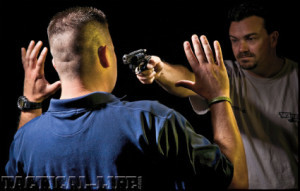 Five Gun Disarm Tips
Five Gun Disarm Tips
Gun disarm techniques are often a heated topic among martial artists and self-defense practitioners. Opinions vary based on styles, experiences, and training backgrounds. But one thing everyone can agree on is the seriousness of the subject. And because of the seriousness of gun disarms, it should be obvious that I can’t offer the be all and end all of techniques in a short blog article. I can, however, provide a few things to consider and a technique that Rich Nance shared with me for this website and my youtube channel.
Learn About Firearms
Gun defense training should also include learning the basics of firearms. Knowing how guns work, how they sound, and how they are used in crimes will better prepare you to defend against them if you have to.
Clear Yourself From The Line Of Fire
You must make sure that your body is not in the line of fire. You do this by moving your body, moving the direction the firearm is pointing, or both. If possible, try to minimize collateral damage should the gun go off during the disarm.
Control The Weapon
Gain and maintain control of the gun. Remember, a committed bad guy will most likely try to pull the gun free if you grab it. You must secure a grip that allows you to control where the muzzle is pointed and provides a way for you to rip the firearm from the bad guy’s hands.
Disarm
Learn techniques that allow you to take the firearm from the bad guy without bringing yourself back into a dangerous position. Some weapon defenses, especially if not done absolutely perfectly bring the muzzle pointed back at the person doing the disarm. It is important to remember that sometimes a disarm can be when you knock the bad guy’s head off with a palm heel chin jab or elbow strike to the jaw that renders him unconscious.
Exit Strategy
Once you have disarmed the gunman, you must determine a safe exit. Do you control the bad guy until police arrive or do you escape immediately to safety? Are there other threats you must contend with? Knowing your state’s laws regarding the use of firearms and self-defense can assist you in making choices that not only save your life, but keep you from legal troubles too.
Gun Disarm Technique with Rich Nance
Here is a short video lesson I asked Rich Nance, police officer, firearm and self-defense instructor, and host of Personal Defense TV, to share:
Gun Disarm Conclusion
Only you can decide the appropriate response and course of action when faced with an armed threat. This is especially true when a firearm in involved. Your environment, the actions of the aggressor, bystanders, and you will all affect the outcome. If you have the right mindset, along with sound training and tactics, you can prevail against an armed attacker. I just hope through awareness you never have to.
(Photo courtesy of Rich Nance)
The post Gun Disarm Tips with Video by Rich Nance appeared first on .
]]>